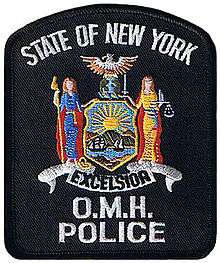New York State Office of Mental Health Police
| New York State Office of Mental Health Police | |
|---|---|
|
New York State Office of Mental Health Police patch | |
| Agency overview | |
| Legal personality | Governmental: Government agency |
| Jurisdictional structure | |
| Operations jurisdiction* | State of New York, USA |
| Legal jurisdiction | Buildings & lands occupied or explicitly controlled by the Office of Mental Health |
| General nature | |
| Operational structure | |
| Footnotes | |
| * Divisional agency: Division of the country, over which the agency has usual operational jurisdiction. | |
The New York State Office of Mental Health Police (OMH Police) is a law enforcement agency that provides on-site safety and security services to the New York State Office of Mental Health grounds and facility within the New York State.
History
The New York State Office of Mental Health Police was created through New York State Mental Hygiene Law to secure the grounds and buildings of the Office of Mental Health as well as to transport Office of Mental Health patients to and from court and other OMH facilities.[1]
Ranks

The Safety and Security titles are separated into three separate ranks: Chief, Sergeant, and Officer. Promotional exams are routinely given to obtain promotional opportunities.
Powers and Authority
New York State OMH Safety and Security Officer are New York State Peace Officer status which is granted under the Mental Hygiene Law (section 7.25) Public Health Law (section 455), and the Criminal Procedure Law (section 2.10–12).[2] The Office of Mental Health uses the civil service title of "Safety and Security Officer.
Equipment
New York State OMH Safety and Security Officers are not authorized to carry firearms as per the NYS CPL. They do carry expandable baton, handcuffs, flashlight, and a radio that is directly linked to other Safety and Security Officers
Training
New York State OMH Safety and Security Officer undergo the peace officer training academy at The New York State Preparedness Training Center (SPTC) located in Central New York.Training for new officers meets or exceeds the "New York State Department of Criminal Justice Services Standards for Peace Officers". The "Peace Officer Basic Course" includes training in:
- Penal Law, Criminal Procedure Law, Vehicle and Traffic Law. Fire, Building and Life Safety Code Enforcement
- Lawful Use of Force-Defensive Tactics, Physical Training
- Crowd/Riot Control
- Arrest Techniques and Processing
- Report Writing
- Patrol Techniques
- Emergency Vehicle Operation.
- Critical Incident Management(ICS)
- Weapons of Mass Destruction
- Computer Operations
- Fire Science, Safety & Investigations Training.
After training each new officer completes a minimum six week on-the-job field training supervised by a Senior Officer from their respective facility.
New York State OMH Safety and Security Officer can issue summonses and effect an arrest(s) on grounds and buildings of the Office of Mental Health. Some of the duties performed by these officers include, but are not limited to, enforcing state and local laws, protecting persons and property, prevent and detect crime, search for and eliminate contraband, performing escorts of patients to off-site facilities and apprehending absconded patients.
New York State Safety and Security Officer are responsible for conducting fire service procedures which include conducting fire drills, fire safety classes, fire extinguisher inspections, and building inspections. Furthermore, they maintain peace and security in the OMH State agency, facility, or community residence. .[3]
See also
- List of law enforcement agencies in New York
- New York State Office of Mental Retardation and Developmental Disabilities Police
References
- ↑ "2006 New York Code – Safety.". JustiaUS Law.com. Justia. Retrieved 31 May 2012.
- ↑ "New York Criminal Procedure Law – ARTICLE 2". New York State Law. NY Criminal Procedure Law. Retrieved 31 May 2012.
- ↑ "Safety and Security Officer 1 / Safety and Security Officer Trainee Hiring Form". Omh.state.ny.us. 2012-02-22. Retrieved 2012-05-19.
External links
- New York State Office of Mental Health (OMH)
- Office of Mental Health in the New York Codes, Rules and Regulations
- Department of Mental Hygiene in the New York Codes, Rules and Regulations
- Information about Kendra's Law, mental health policy in NYC and problems at the NYS Office of Mental Health
- Mentally ill New Yorkers need help, article about overcrowding in NY State psychiatric facilities and response by Mental Health police to overcrowded conditions
- (New York State Office of Mental Health Police video)
- (New York State Office of Mental Health Police video 2)
